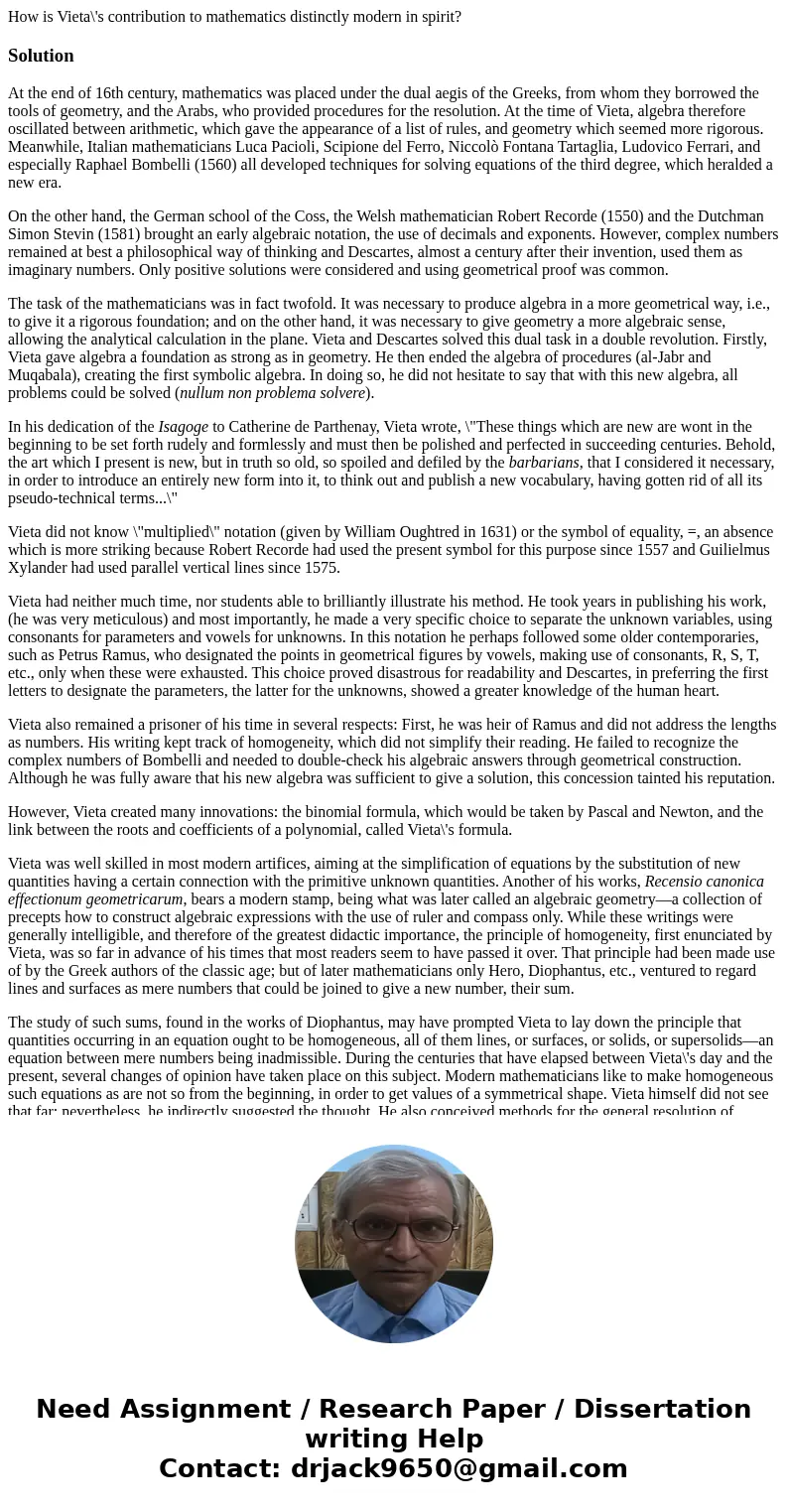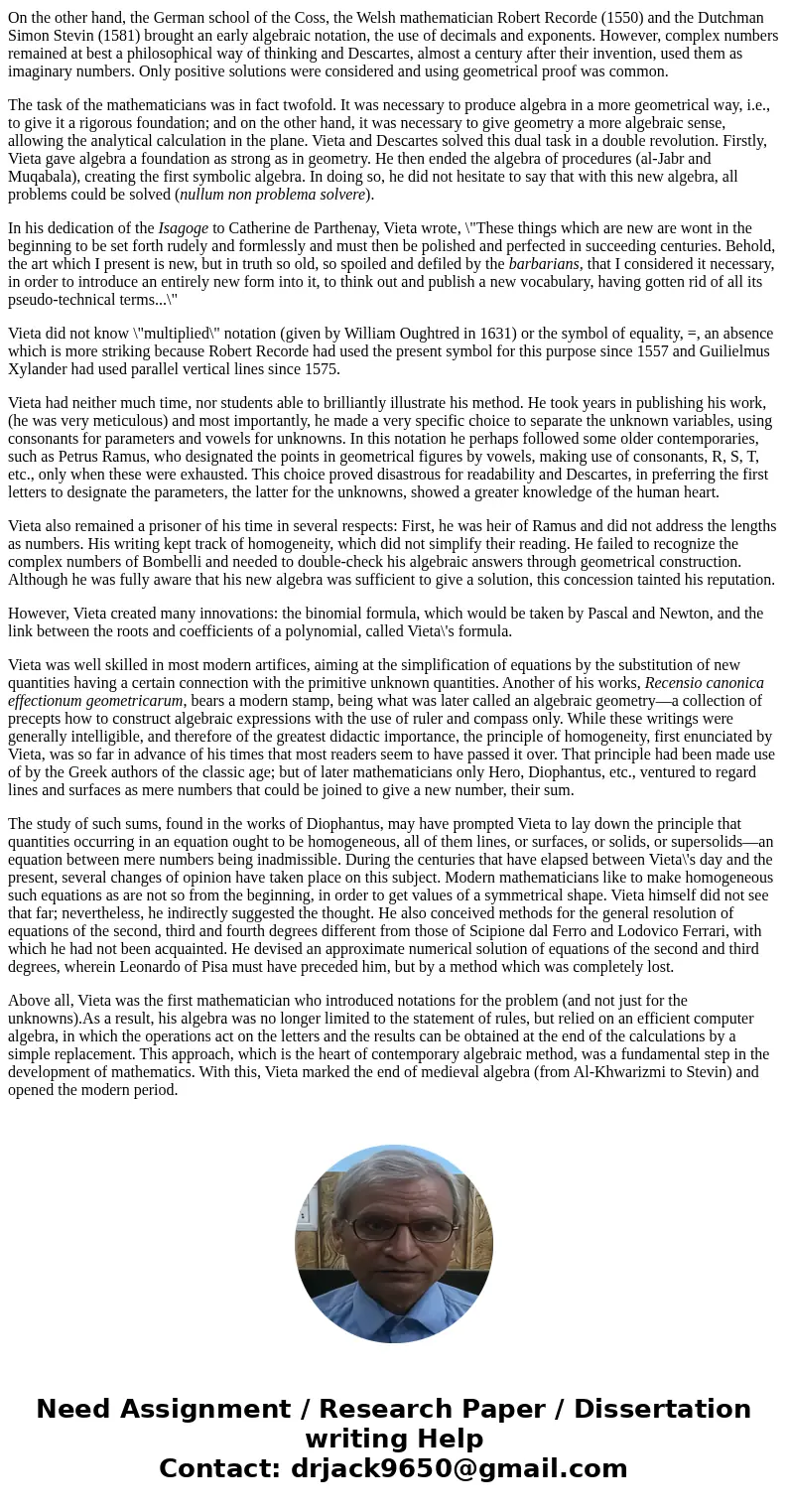How is Vietas contribution to mathematics distinctly modern
How is Vieta\'s contribution to mathematics distinctly modern in spirit?
Solution
At the end of 16th century, mathematics was placed under the dual aegis of the Greeks, from whom they borrowed the tools of geometry, and the Arabs, who provided procedures for the resolution. At the time of Vieta, algebra therefore oscillated between arithmetic, which gave the appearance of a list of rules, and geometry which seemed more rigorous. Meanwhile, Italian mathematicians Luca Pacioli, Scipione del Ferro, Niccolò Fontana Tartaglia, Ludovico Ferrari, and especially Raphael Bombelli (1560) all developed techniques for solving equations of the third degree, which heralded a new era.
On the other hand, the German school of the Coss, the Welsh mathematician Robert Recorde (1550) and the Dutchman Simon Stevin (1581) brought an early algebraic notation, the use of decimals and exponents. However, complex numbers remained at best a philosophical way of thinking and Descartes, almost a century after their invention, used them as imaginary numbers. Only positive solutions were considered and using geometrical proof was common.
The task of the mathematicians was in fact twofold. It was necessary to produce algebra in a more geometrical way, i.e., to give it a rigorous foundation; and on the other hand, it was necessary to give geometry a more algebraic sense, allowing the analytical calculation in the plane. Vieta and Descartes solved this dual task in a double revolution. Firstly, Vieta gave algebra a foundation as strong as in geometry. He then ended the algebra of procedures (al-Jabr and Muqabala), creating the first symbolic algebra. In doing so, he did not hesitate to say that with this new algebra, all problems could be solved (nullum non problema solvere).
In his dedication of the Isagoge to Catherine de Parthenay, Vieta wrote, \"These things which are new are wont in the beginning to be set forth rudely and formlessly and must then be polished and perfected in succeeding centuries. Behold, the art which I present is new, but in truth so old, so spoiled and defiled by the barbarians, that I considered it necessary, in order to introduce an entirely new form into it, to think out and publish a new vocabulary, having gotten rid of all its pseudo-technical terms...\"
Vieta did not know \"multiplied\" notation (given by William Oughtred in 1631) or the symbol of equality, =, an absence which is more striking because Robert Recorde had used the present symbol for this purpose since 1557 and Guilielmus Xylander had used parallel vertical lines since 1575.
Vieta had neither much time, nor students able to brilliantly illustrate his method. He took years in publishing his work, (he was very meticulous) and most importantly, he made a very specific choice to separate the unknown variables, using consonants for parameters and vowels for unknowns. In this notation he perhaps followed some older contemporaries, such as Petrus Ramus, who designated the points in geometrical figures by vowels, making use of consonants, R, S, T, etc., only when these were exhausted. This choice proved disastrous for readability and Descartes, in preferring the first letters to designate the parameters, the latter for the unknowns, showed a greater knowledge of the human heart.
Vieta also remained a prisoner of his time in several respects: First, he was heir of Ramus and did not address the lengths as numbers. His writing kept track of homogeneity, which did not simplify their reading. He failed to recognize the complex numbers of Bombelli and needed to double-check his algebraic answers through geometrical construction. Although he was fully aware that his new algebra was sufficient to give a solution, this concession tainted his reputation.
However, Vieta created many innovations: the binomial formula, which would be taken by Pascal and Newton, and the link between the roots and coefficients of a polynomial, called Vieta\'s formula.
Vieta was well skilled in most modern artifices, aiming at the simplification of equations by the substitution of new quantities having a certain connection with the primitive unknown quantities. Another of his works, Recensio canonica effectionum geometricarum, bears a modern stamp, being what was later called an algebraic geometry—a collection of precepts how to construct algebraic expressions with the use of ruler and compass only. While these writings were generally intelligible, and therefore of the greatest didactic importance, the principle of homogeneity, first enunciated by Vieta, was so far in advance of his times that most readers seem to have passed it over. That principle had been made use of by the Greek authors of the classic age; but of later mathematicians only Hero, Diophantus, etc., ventured to regard lines and surfaces as mere numbers that could be joined to give a new number, their sum.
The study of such sums, found in the works of Diophantus, may have prompted Vieta to lay down the principle that quantities occurring in an equation ought to be homogeneous, all of them lines, or surfaces, or solids, or supersolids—an equation between mere numbers being inadmissible. During the centuries that have elapsed between Vieta\'s day and the present, several changes of opinion have taken place on this subject. Modern mathematicians like to make homogeneous such equations as are not so from the beginning, in order to get values of a symmetrical shape. Vieta himself did not see that far; nevertheless, he indirectly suggested the thought. He also conceived methods for the general resolution of equations of the second, third and fourth degrees different from those of Scipione dal Ferro and Lodovico Ferrari, with which he had not been acquainted. He devised an approximate numerical solution of equations of the second and third degrees, wherein Leonardo of Pisa must have preceded him, but by a method which was completely lost.
Above all, Vieta was the first mathematician who introduced notations for the problem (and not just for the unknowns).As a result, his algebra was no longer limited to the statement of rules, but relied on an efficient computer algebra, in which the operations act on the letters and the results can be obtained at the end of the calculations by a simple replacement. This approach, which is the heart of contemporary algebraic method, was a fundamental step in the development of mathematics. With this, Vieta marked the end of medieval algebra (from Al-Khwarizmi to Stevin) and opened the modern period.


 Homework Sourse
Homework Sourse